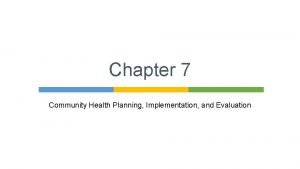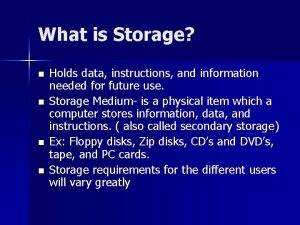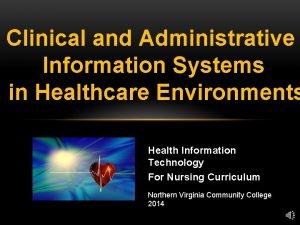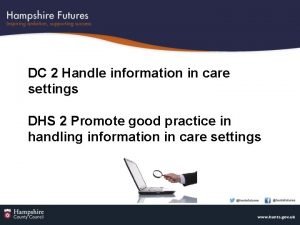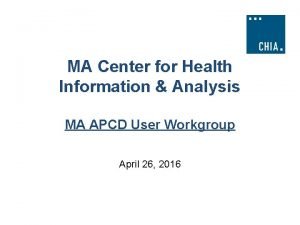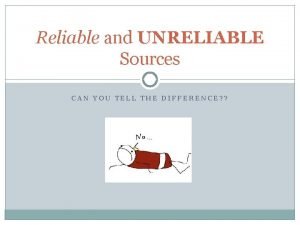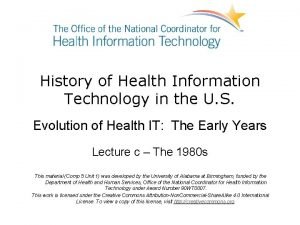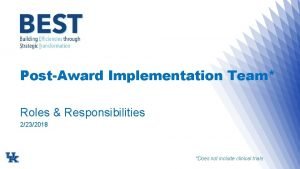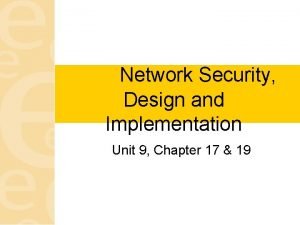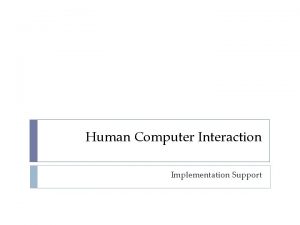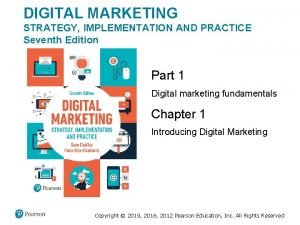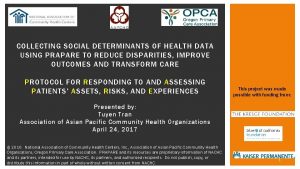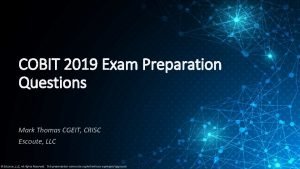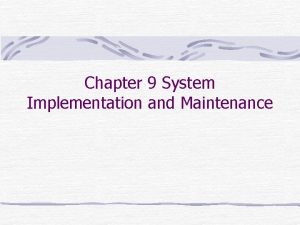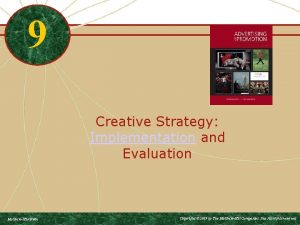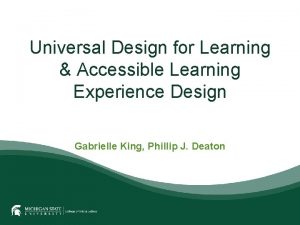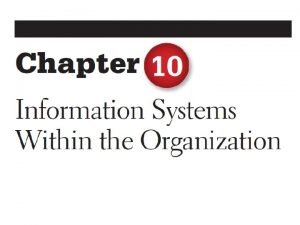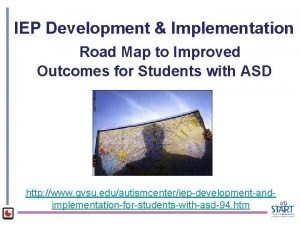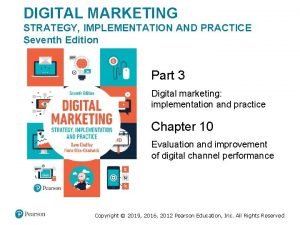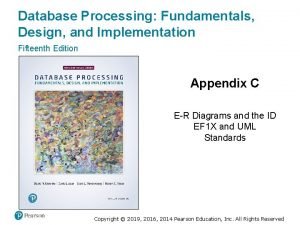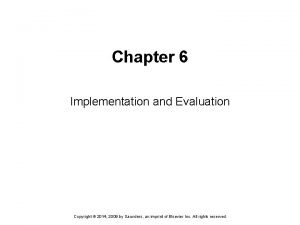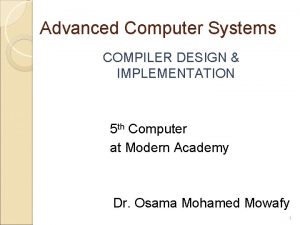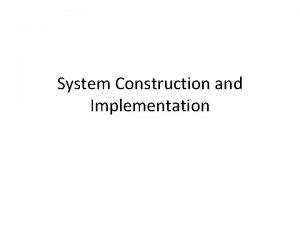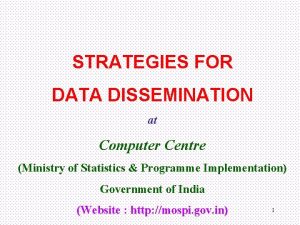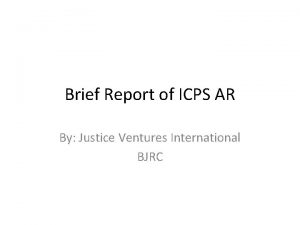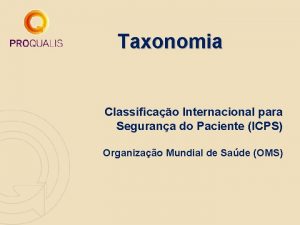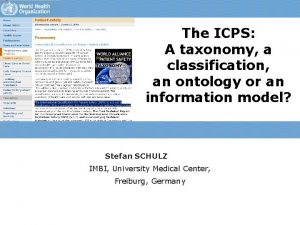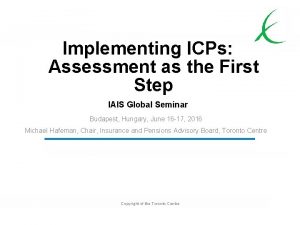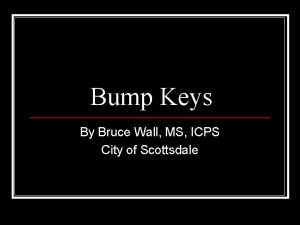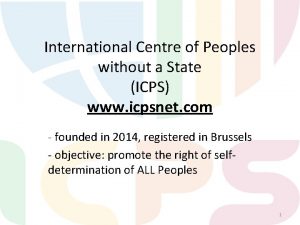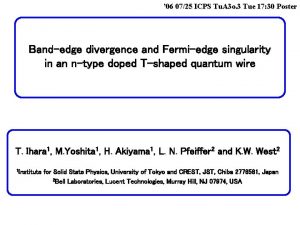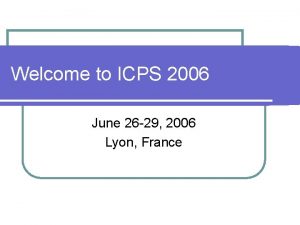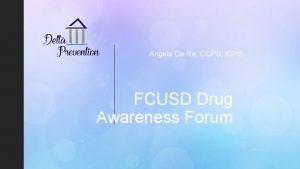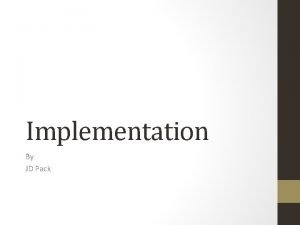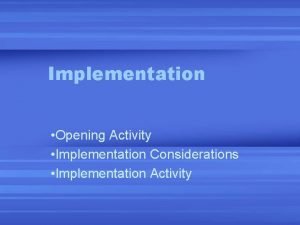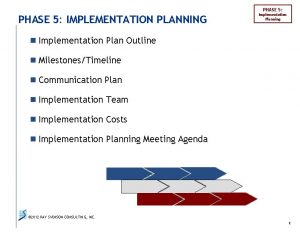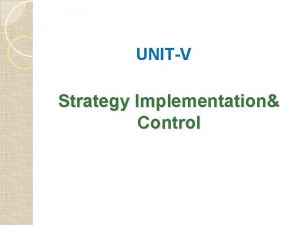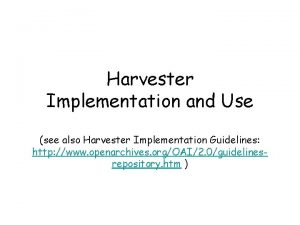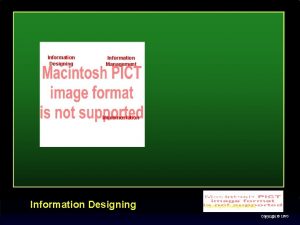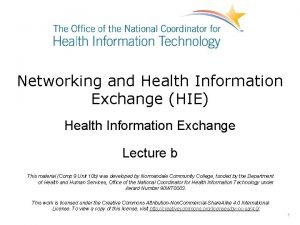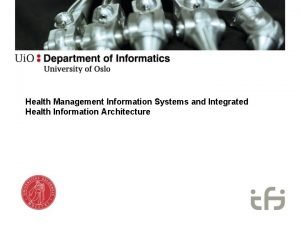Implementation and Use of ICPS in Health Information










































- Slides: 42

Implementation and Use of ICPS in Health Information Systems (HIS) Stefan Schulz Freiburg University Medical Center, Germany

Context: the Debug. IT project • Debug. IT (Detecting and Eliminating Bacteria Usin. G Information Technology) – Patient Safety project – Funded by the European Community's Seventh Framework Program under grant agreement n° FP 7– 217139 (7 M€) – Project period: from Jan 1 st, 2008 to December 31 st, 2011 – 11 Partners • Background: – 50% of antimicrobial drug use is inappropriate – Increasing resistance – new antibiotics can not keep up

Collect Data • Routine clinical data – different hospitals in different countries – in different coding schemes, data and information models – Including free text documents in different languages • • map them to commonly agreed information models rooted in common ontologies organized in a virtualized clinical data repository (CDR). Clinical Data Repository

Learn • • debug. IT learns by detecting PS relevant patterns for the better treatment of infectious diseases Information extraction, knowledge discovery • • structured data mining text mining (from clinical narratives) Clinical Data Repository Data Mining

Store and Author Clinical Knowledge • • debug. IT learns by detecting PS relevant patterns for the better treatment of infectious diseases Information extraction, knowledge discovery • • • Clinical Data Repository Data Mining structured data mining text mining (from clinical narratives) Merged with authoritative knowledge (e. g. clinical practice guidelines) Stored and aggregated in a distributed repository Feeds a translational framework Knowledge Repository

Debug. IT’s Translational Framework • • Decision support for improvement of clinical care (choice, dose and administration of antibiotics) Monitoring to analyze ongoing care activities and outcomes Predicting future outcomes to give additional support to treatment decision Integration in existing clinical information systems enable its selflearning from existing data Clinical Data Repository Data Mining Clinical System Knowledge Repository

Expected Outcome • • “living” knowledge base for supporting clinical information systems of participating hospitals virtualization of clinical data repository information relevant for patient safety advanced multimodal data mining techniques on text image and distributed storage use of machine reasoning related to real, point of care patient data to reduce harm to patients

Semantic framework Information on particulars Patient #123 suspected to be infected by MRSA after heart transplant Clinical Data Repository (information model) • semantic • identifiers Clinical System Debug. IT ontology WP 1 • semantic • identifiers Clinical knowledge “The risk of antibiotic resistance after thoracic surgery is estimated at x“ Analysis Debug. IT Ontologies Knowledge Repository, basis of clinical decisions Invariant meaning of terms / concepts MRSA is defined as SA for which methicillin has no toxic effect”, “Heart transplant implies thoracic surgery”

Can ICPS be used in the Debug. IT framework? • Debug. IT ‘s analysis of the state of ICPS in march 2009 • We expected: – an ontology / classification to be re-used / linked to the Debug. IT ontology • We found: – a list of accurately defined concepts (ICPS 48 “key concepts”), but not represented in an ontology format – a hierarchical reporting template (ICPS “concepts by class”) • We missed: – compliance with basic requirements for clinical vocabularies, e. g. no unique names, no IDs – enough detail for e. g. pathogens, chemicals etc. • Analysis published at MIE 2009

• “Classification” in the “traditional” sense • “ICPS's name and its closeness to the WHO-FIC [9] are misleading. ICPS is neither a classification nor a taxonomy. Its hierarchical tree could be described as an information model or reporting template. As such it is well-thought and may be suited for the purpose being devised for” • Stud Health Technol Inform. 2009; 150: 502 -6; PMID: 19745362

Decision for Debug. IT • In the initial phase ICPS not used (to be re-assessed later) • Construction of an ontology-based clinical information model, to be filled by heterogeneous clinical data • Necessary steps – ontology binding (in Debug. IT: mix of existing and new ontologies) – formal descriptions (using OWL) – mappings from individual information models (complicated if logically consistent) – using text mining to extract information into pre-defined information model • Interesting for ICPS: all these steps would also be necessary when implementing ICPS into HIS • Debug. IT experience: blueprint for implementing ICPS…

Debug. IT Semantic framework adapted to ICPS corresponding to the ICPS 48 “key concepts”. Corresponding to clinical terminologies (e. g. SNOMED CT) clinical information model corresponding to the ICPS “tree”. Comparable to HL 7 and open. EHR archetypes • semantic • identifiers Clinical System ontology Represent invariant meaning WP 1 • semantic • identifiers Debug. IT Ontologies Knowledge Repository, basis of clinical decisions Analysis

HIS aspects and two ICPS use cases • ICPS is used for the standardized and comprehensive reporting of patient safety relevant events: – the initiative comes from the user – the user fills the information template – ideally the system could automatically extract as many information as possible from the HIS (using mapping rules and information extration / text mining): the user has to verify and complete • ICPS is used as a semantic basis for the automated detection of PS relevant events – system takes the initiative and proposes PS candidates – user identifies true positives and performs the steps as explained above

Desiderata from an implementation perspective • Short term – Reconsider what ICPS really is: (novel) classification, information model or reporting template or sth in between? – Use one of the standards for clinical information models (open. EHR archetypes, HL 7 V 3) for representing the ICPS “tree”. Enhance compatibility with existing models (e. g. ICSR and the HL 7 Public Health Reporting Domain Information Model) • Long term: – formally describe the meaning of the ICPS data elements in terms of a clinical ontology drawing upon the ICPS “ 48 key concepts” – feeding the ICPS “ 48 key concepts” into a terminological / ontological standard (e. g. SNOMED CT)

Ontologies, Classifications and Information Models Ontologies Formal descriptions • MRSA subtype-of SA • SA subtype-of Staphylococcus • SA implies bearer-of some MR quality Textual descriptions • “MRSA is defined as SA for which methicillin has no toxic effect” • theories that attempt to give precise mathematical formulations of the properties and relations of certain entities. (Stanford Encyclopedia of Philosophy) Future Classifications ? ? Information Models Methicillin resistance o. Clinically confirmed o. Confirmed by antibiogram o. Suspected o. None o. Unknown • artifacts in which information is recorded A. Rector, Semantic. Health D 6. 1


The ICPS: A taxonomy, a classification, an ontology or an information model? Stefan SCHULZ IMBI, University Medical Center, Freiburg, Germany

Representation Artifacts Ontology • theory of reality Epistemology Ontologies • theories that attempt to give precise mathematical formulations of the properties and relations of certain entities. (Stanford Encyclopedia of Philosophy) Information Models • theory of knowledge • artifacts in which information is recorded A. Rector, Semantic. Health D 6. 1

Representation Artifacts Ontologies Formal descriptions • MRSA subtype-of SA • SA subtype-of Staphylococcus • SA implies bearer-of some MR quality Textual descriptions • “MRSA is defined as SA for which methicillin has no toxic effect” • theories that attempt to give precise mathematical formulations of the properties and relations of certain entities. (Stanford Encyclopedia of Philosophy) Information Models Methicillin resistance o. Clinically confirmed o. Confirmed by antibiogram o. Suspected o. None o. Unknown • artifacts in which information is recorded A. Rector, Semantic. Health D 6. 1

Representation Artifacts Ontologies Taxonomies Backbone of Ontologies Formal descriptions • MRSA subclass-of SA • SA subclass-of Staphylococcus • SA implies bearer-of some MR quality Sub. Class or is-a relation: a class B is a subclass of a class A if and only if all members of B are also members of A (ENV 12264: 2005, Horrocks 2003) Textual descriptions • “MRSA is defined as SA for which methicillin has no toxic effect” Information Models Methicillin resistance o. Clinically confirmed o. Confirmed by antibiogram o. Suspected o. None o. Unknown • artifacts in which information is recorded A. Rector, Semantic. Health D 6. 1

Taxonomy building principles Individuals (particulars, instances)

Taxonomy building principles Class Individuals (particulars, instances)

Taxonomy building principles Class Subclasses Individuals (particulars, instances)

Taxonomy building principles is-a or subclass relation (relating classes with classes): corresponds to subset relation Class Subclasses instance-of relation (relating individuals with classes) corresponds to set membership relation Individuals (particulars, instances)

Representation Artifacts Ontologies Formal descriptions • MRSA subtype-of SA • SA subtype-of Staphylococcus • SA implies bearer-of some MR quality Textual descriptions • “MRSA is defined as SA for which methicillin has no toxic effect” Taxonomies Backbone of Ontologies Sub. Class or is-a relation: Classifications a class B is a subclass of a class A Taxonomies with additional if and only if building principles: all members of B are also members of A - exhaustiveness (ENV 12264: 2005, Horrocks 2003) - disjointness Information Models Methicillin resistance o. Clinically confirmed o. Confirmed by antibiogram o. Suspected o. None o. Unknown • artifacts in which information is recorded A. Rector, Semantic. Health D 6. 1

Classifications: Disjointness principle Classifications, e. g. ICD Other Terminologies, e. g. SNOMED CT

Representation Artifacts Ontologies Taxonomies Classifications ICPS ? Information Models

Three components of ICPS “Conceptual Framework” “Key Concepts” 9. Hazard: a circumstance, agent or action with the potential to cause harm. 10. Circumstance: a situation or factor that may influence an event, agent or person(s). 11. Event: something that happens to or involves a patient. 12. Agent: a substance, object or system which acts to produce change. 13. Patient Safety: the reduction of risk of unnecessary harm associated with healthcare to an acceptable minimum. 14. Healthcare-associated harm: harm arising from or associated with plans or actions taken during the provision of healthcare, rather than an underlying disease or injury. 15. Patient safety incident: an event or circumstance which could have ICPS "taxonomy"

Three components of ICPS “Conceptual Framework” “Key Concepts” 9. Hazard: a circumstance, agent or action with the potential to cause harm. 10. Circumstance: a situation or factor that may influence an event, agent or person(s). 11. Event: something that happens to or involves a patient. 12. Agent: a substance, object or system which acts to produce change. 13. Patient Safety: the reduction of risk of unnecessary harm associated with healthcare to an acceptable minimum. 14. Healthcare-associated harm: harm arising from or associated with plans or actions taken during the provision of healthcare, rather than an underlying disease or injury. 15. Patient safety incident: an event or circumstance which could have ICPS "taxonomy"

ICPS Components ICPS "taxonomy" “Conceptual Framework” Incident Characteristics “Key Concepts” 9. 10. 11. 12. 13. 14. 15. Hazard: a circumstance, agent or action with the potential to cause harm. Circumstance: a situation or factor that may influence an event, agent or person(s). Event: something that happens to or involves a patient. Agent: a substance, object or system which acts to produce change. Patient Safety: the reduction of risk of unnecessary harm associated with healthcare to an acceptable minimum. Healthcare-associated harm: harm arising from or associated with plans or actions taken during the provision of healthcare, rather than an underlying disease or injury. Patient safety incident: an event or circumstance which could have resulted, or did result, in unnecessary harm to a patient.

ICPS Conceptual Framework “Conceptual Framework” “Key Concepts” 9. 10. 11. 12. 13. 14. 15. Hazard: a circumstance, agent or action with the potential to cause harm. Circumstance: a situation or factor that may influence an event, agent or person(s). Event: something that happens to or involves a patient. Agent: a substance, object or system which acts to produce change. Patient Safety: the reduction of risk of unnecessary harm associated with healthcare to an acceptable minimum. Healthcare-associated harm: harm arising from or associated with plans or actions taken during the provision of healthcare, rather than an underlying disease or injury. Patient safety incident: an event or circumstance which could have resulted, or did result, in unnecessary harm to a patient. ICPS "taxonomy"

Analyzing ICPS • target of analysis: the ICPS tree… – graph structure: resemblance with WHO-FIC classifications (4 – 5 levels, single parents) – artifact meant to be used by coders • key concepts and conceptual framework: meta information from user’s point of view 9. 10. 11. 12. 13. 14. Hazard: a circumstance, agent or action with the potential to cause harm. Circumstance: a situation or factor that may influence an event, agent or person(s). Event: something that happens to or involves a patient. Agent: a substance, object or system which acts to produce change. Patient Safety: the reduction of risk of unnecessary harm associated with healthcare to an acceptable minimum. Healthcare-associated harm: harm arising from or associated with plans or actions taken during the provision of healthcare,

ICPS is in a strict sense not… A member of the class Person Reporting is not a member of the class Discovery of Incident: No taxonomic link! But For every member of the class Discovery of Incident” there is some member of the class Person Reporting as a participant: non-taxonomic, ontological relation A member of the class Country is not a member of the class Where and no member of Discovery of Incident. No taxonomic link! But: for every member of the class Discovery of Incident” there is some member of the class Country as a location: non-taxonomic, ontological relation … a taxonomy (ENV 12264: 2005, Cornet 2006) • • Semantic nature of hierarchic links are not specified Subclass or is-a relation: a class B is a subclass of a class A if and only if all members of B are also members of A (ENV 12264: 2005, Horrocks 2003)

ICPS is not yet… … a classification (ISO 17115: 2007, Ingenerf MIM 1998, Madden [WHO-FIC] 2007) • Criterion of mutually disjoint, exhaustive classes not fulfilled • more than hundred ICPS concepts occur more than once in different hierarchies – Healthcare Professional occurs both as a child of People Involved and Person Reporting

ICPS: What it is now “Conceptual Framework” “Key Concepts” 9. Hazard: a circumstance, agent or action with the potential to cause harm. 10. Circumstance: a situation or factor that may influence an event, agent or person(s). 11. Event: something that happens to or involves a patient. 12. Agent: a substance, object or system which acts to produce change. 13. Patient Safety: the reduction of risk of unnecessary harm associated with healthcare to an acceptable minimum. 14. Healthcare-associated harm: harm arising from or associated with plans or actions taken during the provision of healthcare, rather than an underlying disease or injury. 15. Patient safety incident: an event or circumstance which could have ICPS "taxonomy"

ICPS: What it is now This is a rudimentary, informal “Concepts ontology by Class” “Conceptual Framework” • describes terms by their generic properties • close to upper-level ontologies (e. g. Bio. Top): “state”, “substance”, “event”, “agent”, “object”, “action”, “quality”. “Key Concepts” 9. Hazard: a circumstance, agent or action with the potential to cause harm. 10. Circumstance: a situation or factor that may influence an event, agent or person(s). 11. Event: something that happens to or involves a patient. 12. Agent: a substance, object or system which acts to produce change. 13. Patient Safety: the reduction of risk of unnecessary harm associated with healthcare to an acceptable minimum. 14. Healthcare-associated harm: harm arising from or associated with plans or actions taken during the provision of healthcare, rather than an underlying disease or injury. 15. Patient safety incident: an event or circumstance which could have

ICPS: What it is now “Conceptual Framework” “Key Concepts” 9. Hazard: a circumstance, agent or action with the potential to cause harm. 10. Circumstance: a situation or factor that may influence an event, agent or person(s). 11. Event: something that happens to or involves a patient. 12. Agent: a substance, object or system which acts to produce change. 13. Patient Safety: the reduction of risk of unnecessary harm associated with healthcare to an acceptable minimum. 14. Healthcare-associated harm: harm arising from or associated with plans or actions taken during the provision of healthcare, rather than an underlying disease or injury. 15. Patient safety incident: an event or circumstance which could have ICPS "taxonomy" This is a complex patient safety model • Similarity with - workflows - business models - Ontologically: - complex event type

ICPS: What it is now “Conceptual Framework” This is a structured data acquisition template consisting of (mostly) binary fields Can be described as information model Hierarchical parents provide context information for fields (but are not superclasses) “Key It Hazard: is not meant. Concepts” to arrange classes 9. a circumstance, agent or action with the potential to cause ofharm. entities by their inherent 10. Circumstance: a situation or factor that may influence an event, agent or person(s). (ontology), but gives a properties 11. Event: something that happens to or involves a patient. what a 12. framework Agent: a substance, for objectacquiring or system which acts to produce change. person 13. reporting Patient Safety: the reduction of knows risk of unnecessary harm associated with healthcare to an acceptable minimum. (information model) 14. Healthcare-associated harm: harm arising from or associated with plans or actions taken during the provision of healthcare, rather than an underlying disease or injury. 15. Patient safety incident: an event or circumstance which could have ICPS "taxonomy"

Representation Artifacts Ontologies Formal descriptions • MRSA subtype-of SA • SA subtype-of Staphylococcus • SA implies bearer-of some MR quality Textual descriptions • “MRSA is defined as SA for which methicillin has no toxic effect” • theories that attempt to give precise mathematical formulations of the properties and relations of certain entities. (Stanford Encyclopedia of Philosophy) Information Models Methicillin resistance o. Clinically confirmed o. Confirmed by antibiogram o. Suspected o. None o. Unknown • artifacts in which information is recorded A. Rector, Semantic. Health D 6. 1

Structure of the Talk • ICPS: How does it look like? • ICPS: What it isn’t • ICPS: What it is now • ICPS: What it may be in the future

What ICPS may be in the future • After finishing, ICPS has the potential to be universally accepted as a reporting standard • The ICPS “key concepts” may become a fully-fledged formal ontology rooted in existing upper-level ontologies and using Semantic Web standards (OWL) and being linked to ontological / terminological standards like SNOMED CT • The ICPS “conceptual framework” can be enhanced by formal descriptions • The ICPS reporting template ("taxonomy") may then be fully described in terms of ICPS’s ontological core • but…

Open issues • The needs for semantically interoperable patient-safety relevant event reporting is essentially different from the reporting of diseases • For the latter, the format of a statistical classification is adequate (ICD-10) • Is the format of a reporting template adequate for the purpose ICPS is devised for? • Is it necessary to transform the ICPS tree into a real taxonomy or classification structure?
 Differences between health promotion and health education
Differences between health promotion and health education Assessment planning implementation and evaluation
Assessment planning implementation and evaluation Information security implementation
Information security implementation Health and social care component 3
Health and social care component 3 How you use ict today and how you will use it tomorrow
How you use ict today and how you will use it tomorrow Storage holds for future use
Storage holds for future use Opportunities of media in economy
Opportunities of media in economy Read the advertisement below
Read the advertisement below It holds data instructions and information for future use
It holds data instructions and information for future use Chapter 3 health wellness and health disparities
Chapter 3 health wellness and health disparities Difference between counselling and health education
Difference between counselling and health education Chapter 1 understanding health and wellness lesson 2
Chapter 1 understanding health and wellness lesson 2 Chapter 1 lesson 1 your total health
Chapter 1 lesson 1 your total health Administrative information system in healthcare
Administrative information system in healthcare Handle information in care settings
Handle information in care settings Center for health information and analysis
Center for health information and analysis Reliable and unreliable sources
Reliable and unreliable sources History and evolution of health information technology
History and evolution of health information technology Implementation team roles and responsibilities
Implementation team roles and responsibilities Network security design
Network security design Hrd program implementation
Hrd program implementation Implementation support in hci
Implementation support in hci Digital marketing strategy implementation and practice
Digital marketing strategy implementation and practice Uiecu hours
Uiecu hours Prapare
Prapare Cobit 2019 exam questions
Cobit 2019 exam questions System maintenance must be performed to
System maintenance must be performed to Implementing strategies marketing finance/accounting
Implementing strategies marketing finance/accounting System design implementation and operation
System design implementation and operation Transformational ad
Transformational ad Accessible learning experience design and implementation
Accessible learning experience design and implementation Intune deployment project plan
Intune deployment project plan Objective of transaction processing system
Objective of transaction processing system Iep development and implementation
Iep development and implementation Digital marketing strategy implementation and practice
Digital marketing strategy implementation and practice Fundamentals of design
Fundamentals of design Marketing organization implementation and control
Marketing organization implementation and control Chapter 6 implementation and evaluation
Chapter 6 implementation and evaluation Staffing issues in strategy implementation
Staffing issues in strategy implementation Channel design and implementation
Channel design and implementation Advanced compiler design and implementation
Advanced compiler design and implementation System construction phase
System construction phase Ministry of statistics and programme implementation
Ministry of statistics and programme implementation

